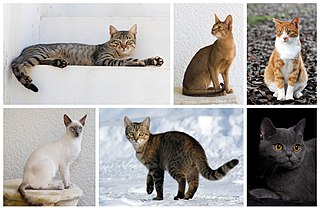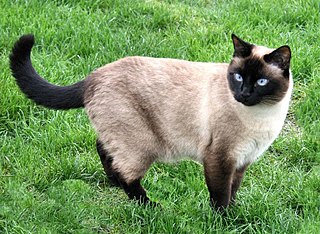History
Although some experimental breeding took place during the 1970s and 1980s in the UK, including Pat Turner's Seychellois breeding program, modern-day Oriental bicolours owes their origins to matings initiated in the United States by Lindajean Grillo of Ciara Cattery. Starting in 1979, Grillo carried out a series of matings between Siamese and bicoloured American Shorthair. She then selected the best bicoloured offspring to mate back to Siamese or Orientals in order to regain type. The variety was granted recognition by TICA in 1983 and the first champion was Ciara Quite-N-Oreo.
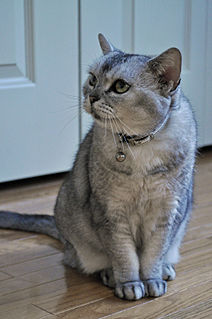
The American Shorthair (ASH) is a breed of domestic cat believed to be descended from European cats brought to North America by early settlers to protect valuable cargo from mice and rats. According to the Cat Fancier's Association, in 2012, it was the seventh most popular pedigreed cat in the United States.

The International Cat Association (TICA) is considered the world's largest genetic cat registry. Originally a North American organization, it now has a worldwide presence. The organization has a genetic registry for pedigreed and household pet cats and is one of the world's largest sanctioning bodies for cat shows.
During the 1980s, European breeders, principally those in France and the Netherlands, initiated their own Oriental bicolour breeding lines. A red and white female Moroccan street cat was used as an initial outcross, then later on a Black & White Cornish Rex. Further cats were imported from the USA. It was important for breeders to have different lines in order to be able to mate bicolour to bicolour and obtain a higher proportion of white on the coat, without excessive inbreeding.
Out-crossing or out-breeding means the crossing between different breeds and no common ancestors. This is the practice of introducing unrelated genetic material into a breeding line. It increases genetic diversity, thus reducing the probability of an individual being subject to disease or genetic abnormalities.
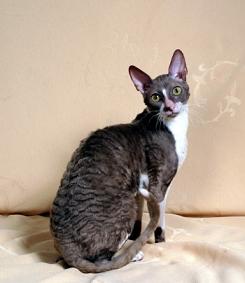
A Cornish Rex is a breed of domestic cat. The Cornish Rex has no hair except for down. Most breeds of cat have three different types of hair in their coats: the outer fur or "guard hairs", a middle layer called the "awn hair"; and the down hair or undercoat, which is very fine and about 1 cm long. Cornish Rexes only have the undercoat. They are prone to hair loss and many will develop a very thin coat or even go bald over large parts of their body. The curl in their fur is caused by a different mutation and gene than that of the Devon Rex. The breed originated in Cornwall, Great Britain.
FIFe granted championship recognition in 2003 to the bicoloured Oriental Shorthairs and in 2005 to the colourpoint and white cats under the breed name Seychellois.
Although there was a small breeding program stemming from the last of Pat Turner's cats being kept by Barbara Lambert (Nomis cattery, breeding under FIFe guidelines), this disappeared following her death in the early 2000s. The first modern-day Oriental bicolours were imported to the UK starting in 2004 with the arrival of Black & White male Tassam Tom of Landican owned by Sarah Johnson and Pat Norman of the Landican Cattery. The variety gained official Preliminary recognition with the GCCF in 2006. In 2008 the breed progressed to Provisional Status, the fastest breed recognition within this organisation and a mark of the breed's popularity and success.
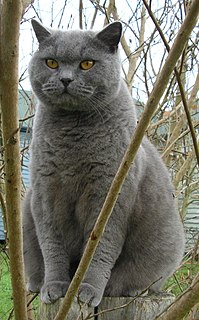
The British Shorthair is the pedigreed version of the traditional British domestic cat, with a distinctively chunky body, dense coat, and broad face. The most familiar color variant is the "British Blue," a solid blue-grey coat, copper eyes, and a medium-sized tail. The breed has also been developed in a wide range of other colours and patterns, including tabby and colorpoint.
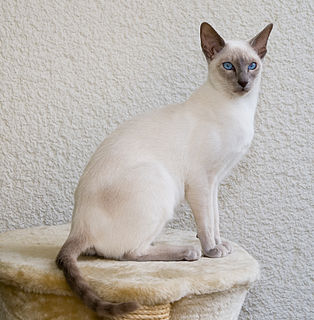
The Siamese cat is one of the first distinctly recognized breeds of Asian cat. Derived from the Wichianmat landrace, one of several varieties of cat native to Thailand, the Siamese became one of the most popular breeds in Europe and North America in the 19th century. The carefully refined modern Siamese is characterized by blue almond-shaped eyes; a triangular head shape; large ears; an elongated, slender, and muscular body; and various forms of point colouration. Other than colouration, the modern Siamese bears little resemblance to the original stock, and the more moderate, traditional or "old-style" Siamese, with a much rounder head and body, has been re-established by multiple registries as the Thai cat). The International Cat Association describes the modern Siamese as affectionate, social, intelligent, and playful into adulthood, often enjoying a game of fetch. Siamese tend to seek human interaction and also like companionship from other cats.

A bicolor cat or piebald cat is a cat with white fur combined with fur of some other color, for example black or tabby. There are various patterns of bicolor cat. These range from Turkish Van pattern through to solid color with a throat locket.

The Selkirk Rex is a breed of cat with highly curled hair.

The Exotic Shorthair is a breed of cat developed as a short-haired version of the Persian. The Exotic is similar to the Persian in many ways, including temperament and conformation, a flat nose and face with the exceptions of the short dense coat.

The Korat is a silver-tipped blue-grey, short-haired breed of domestic cat with a small to medium build and a low percentage of body fat. Its body is semi-cobby, and unusually heavy for its size. It is an intelligent and playful active cat that forms strong bonds with people. Among the Korat's distinguishing characteristics are its heart-shaped head and large green eyes.
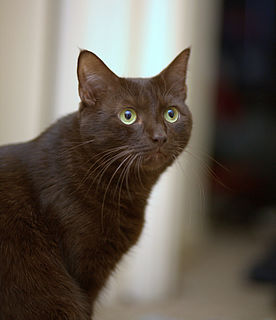
The Havana Brown was the result of a planned breeding between Siamese and domestic black cats, by a group of cat fanciers in England, in the 1950s. Early breeders introduced a Siamese type Russian Blue into their breeding. However, using current genetic testing, it is believed that almost none remain in the gene pool.

The Javanese, also known as the ColorpointLonghair in some registries, is a variety of purebred domestic cat. It is an Oriental-type, the long-haired equivalent of the Colorpoint Shorthair. The variety was developed in North America; its name is derived from the tradition of naming Oriental-type cats after Southeast Asian places. It is an offshoot of the Balinese breed, out-crossed to Siamese and Colorpoint Shorthair, and often having coat patterns not acceptable in those breeds. Individuals may or may not be have point coloration.

The Oriental Shorthair is a breed of domestic cat developed from and closely related to the Siamese. It maintains the modern Siamese head and body type but appears in a wide range of coat colors and patterns. Like the Siamese, Orientals have almond-shaped eyes, a triangular head shape, large ears, and an elongated, slender, and muscular body. Their personalities are also very similar. Orientals are social, intelligent, and many are rather vocal. They often remain playful into adulthood, with many enjoying playing fetch. Despite their slender appearance, they are athletic and can leap into high places. They prefer to live in pairs or groups and also seek human interaction. Unlike the breed's blue-eyed forebear, Orientals are usually green-eyed. The Oriental Longhair differs only with respect to coat length.

The Snowshoe is a breed of cat originating in the United States of America in the 1960s. Snowshoes were first produced in Philadelphia when a Siamese breeder's cat gave birth to three kittens with white feet. The breeder, Dorothy Hinds-Daugherty, then began a breeding program to produce what were originally called "Silver Laces", crossing the strangely marked Siamese cats with bi-color American Shorthair cats and other breeds. When Hinds-Daugherty left the program, Vikki Olander began working with the cats and recruited new breeders, as well as worked towards full recognition within cat associations. Despite having existed for 45 years, Snowshoes are rare due to the difficulty of reproducing the correct coat markings. The marks are based on recessive genes for color points and on the co-dominant but variably-expressed piebald pattern gene, making it difficult to predict the appearance of offspring.
The Governing Council of the Cat Fancy (GCCF) is a cat registry, established in 1910 and the largest organisation that registers pedigree cats in the United Kingdom. It was formed from a small number of cat clubs which were registering cats at the time when the modern cat fancy was in its first stages. It is considered to be the original prototype for cat fancy registries. It is an independent body with around 150 member clubs, including specialist breed clubs and area clubs covering particular regions. The GCCF became an incorporated company on 5 November 2010. It licenses cat shows put on by its affiliated clubs with about 135 shows per year. Pedigree cats shown at these shows can gain the titles Champion, Grand Champion, Imperial Grand Champion and Olympian. The latter having three levels, Bronze, Silver and Gold. The word Champion is replaced by Premier for neutered cats. The showing of non-pedigree cats and Pedigree Pets is also popular at GCCF shows.

The Donskoy cat, also known as Don Sphynx or Russian Hairless, is a hairless cat breed of Russian origin. It is not related to the better-known mostly hairless breed of cat, the Sphynx cat, also known as the Canadian Hairless, whose characteristic hairlessness is caused by a recessive mutation in the keratin 71 gene, whereas the Donskoy's hairlessness is caused by a dominant mutation.

The Chantilly-Tiffany or Chantilly/Tiffany, also known as the Chantilly or the Foreign Longhair. The breed originated in North America. The Chantilly was thought extinct until the 1960s when two of these cats appeared during an estate sale.

Colorpoint Shorthairs are a variety of domestic cat. Depending on the cat registry, they may be considered a separate breed of cat, or more often a variant of a pre-existing one, if accepted at all. These cats are distinguished by their conformance to wide range of sixteen different point colors, beyond the four standard Siamese colors. The variety was initially created by crossbreeding Siamese with the American Shorthair – the same mixture that created the Oriental Shorthair, but with different goals. The Colorpoint Shorthair shares the point-coloration pattern with the Siamese, but in the nontraditional colors of red, cream, tortoiseshell, and lynx (tabby) points, and minor variations thereof. In body style, head shape, and other features, it may be intermediate between the two foundation breeds, which show cats leaning toward Siamese traits. Those who favour the Traditional Siamese look may also favour the more moderate-typed Colorpoint Shorthairs that take after their American Shorthair ancestors in shape.

The Peterbald is a cat breed of Russian origin. It was created in St Petersburg in 1994 from an experimental breeding by Olga S. Mironova. They resemble Oriental Shorthairs with a hair-losing gene. The breed was accepted for Championship class competition in 2009.
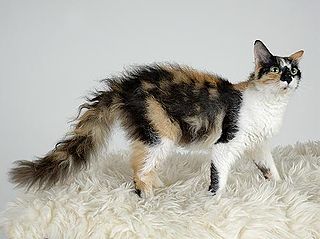
The LaPerm is a breed of cat. A LaPerm's fur is curly, with the tightest curls being on the belly, throat and base of the ears. LaPerms come in many colors and patterns. LaPerms generally have a very affectionate personality.
A cat registry or cat breed registry, also known as a cat fancier organisation, cattery federation, or cat breeders' association, is an organisation that registers domestic cats of many breeds, for exhibition and for breeding lineage tracking purposes. A cat registry stores the pedigrees (genealogies) of cats, cattery names, and other details of cats; studbooks, breed descriptions, and the formal breed standards ; lists of judges qualified to judge at shows run by or affiliated with that registry; and sometimes other information. A cat registry is not the same as a breed club or breed society. Cat registries each have their own rules and usually also organise or license (sanction) cat shows. The show procedures vary widely, and awards won in one registry are not normally recognised by another. Some registries only serve breeders, while others are oriented toward pet owners and provide individual as well as cattery memberships, while yet others are federations only deal with breed clubs or even other registries as intermediaries between the organisation and breeders.
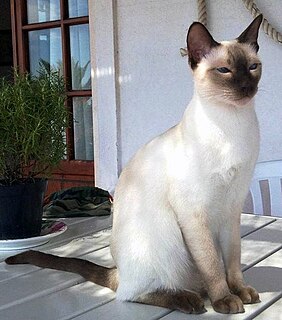
The Thai or Wichien Maat is a newly renamed but old cat breed, related to but distinct from the Western, modern Siamese cat. This natural breed is descended from the cats of Thailand, and, among various groups of breeders in different times and places has also been called the Old-Style Siamese, Traditional Siamese, Classic Siamese; Wichien Maat ; and the Applehead, a nickname that originated in the 1950s as a pejorative used by breeders of the modern-style Siamese. According to The International Cat Association: "The Thai is the breed dedicated to preserving the native pointed cat of Thailand in as close to its original form as possible."

The Persian cat is a long-haired breed of cat characterized by its round face and short muzzle. It is also known as the "Persian Longhair" in the English-speaking countries. In the Middle East region, they are widely known as "Iranian cat" and in Iran they are known as "Shiraz cat". The first documented ancestors of the Persian were imported into Italy from Iran around 1620. Recognized by the cat fancy since the late 19th century, it was developed first by the English, and then mainly by American breeders after the Second World War. Some cat fancier organizations' breed standards subsume the Himalayan and Exotic Shorthair as variants of this breed, while others treat them as separate breeds.

